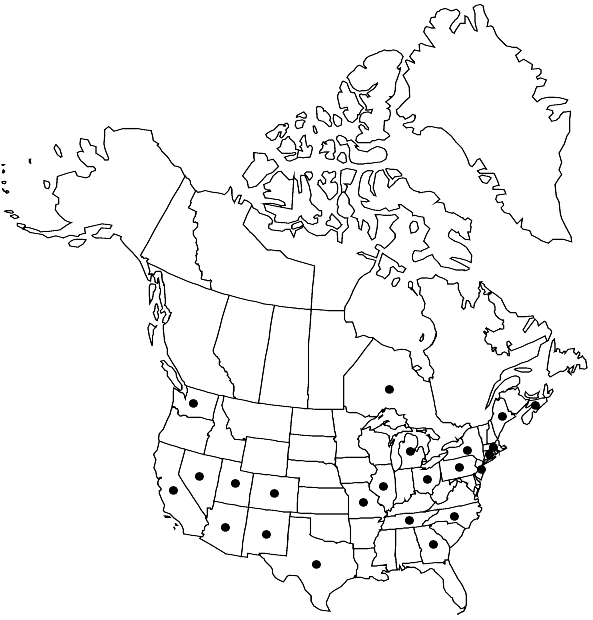Difference between revisions of "Syntrichia papillosa"
Laubm.-Fl. Oestrr.-Ung., 141. 1882,.
FNA>Volume Importer |
imported>Volume Importer |
||
| (6 intermediate revisions by 2 users not shown) | |||
| Line 6: | Line 6: | ||
|place=141. 1882, | |place=141. 1882, | ||
}} | }} | ||
| − | |basionyms={{Treatment/ID/ | + | |basionyms={{Treatment/ID/Basionym |
|name=Tortula papillosa | |name=Tortula papillosa | ||
|authority=Wilson | |authority=Wilson | ||
| + | |rank=species | ||
| + | |publication_title=London J. Bot. | ||
| + | |publication_place=4: 193. 1845 | ||
}} | }} | ||
|synonyms= | |synonyms= | ||
| Line 24: | Line 27: | ||
|elevation=low to high elevations | |elevation=low to high elevations | ||
|distribution=N.S.;Ont.;Ariz.;Calif.;Colo.;Conn.;Ga.;Ill.;Maine;Mass.;Mich.;Mo.;Nev.;N.J.;N.Mex.;N.Y.;N.C.;Ohio;Pa.;Tenn.;Tex.;Utah;Wash.;Mexico;South America (Brazil;Colombia;Ecuador);Europe;s Africa;Atlantic Islands (Falkland Islands);Pacific Islands (New Zealand);Australia. | |distribution=N.S.;Ont.;Ariz.;Calif.;Colo.;Conn.;Ga.;Ill.;Maine;Mass.;Mich.;Mo.;Nev.;N.J.;N.Mex.;N.Y.;N.C.;Ohio;Pa.;Tenn.;Tex.;Utah;Wash.;Mexico;South America (Brazil;Colombia;Ecuador);Europe;s Africa;Atlantic Islands (Falkland Islands);Pacific Islands (New Zealand);Australia. | ||
| − | |discussion=<p>The leaves of Syntrichia papillosa have unipapillose cells, with the papillae only on the abaxial surface, strongly papillose-serrate costae, and small, smooth, brown propagula borne on the adaxial surface of the costa. The plants superficially resemble S. laevipila in the field, but the position and nature of the propagula as well as the incurved leaf margins and roughened back of the costa distinguish S. papillosa, even with a hand lens. Sporophytes are known only from Australia, Tasmania, and New Zealand.</p> | + | |discussion=<p>The leaves of <i>Syntrichia papillosa</i> have unipapillose cells, with the papillae only on the abaxial surface, strongly papillose-serrate costae, and small, smooth, brown propagula borne on the adaxial surface of the costa. The plants superficially resemble <i>S. laevipila</i> in the field, but the position and nature of the propagula as well as the incurved leaf margins and roughened back of the costa distinguish <i>S. papillosa</i>, even with a hand lens. Sporophytes are known only from Australia, Tasmania, and New Zealand.</p> |
|tables= | |tables= | ||
|references= | |references= | ||
| Line 33: | Line 36: | ||
-->{{#Taxon: | -->{{#Taxon: | ||
name=Syntrichia papillosa | name=Syntrichia papillosa | ||
| − | |||
|authority=(Wilson) Juratska | |authority=(Wilson) Juratska | ||
|rank=species | |rank=species | ||
| Line 47: | Line 49: | ||
|publication year= | |publication year= | ||
|special status= | |special status= | ||
| − | |source xml=https:// | + | |source xml=https://bitbucket.org/aafc-mbb/fna-data-curation/src/2e0870ddd59836b60bcf96646a41e87ea5a5943a/coarse_grained_fna_xml/V27/V27_903.xml |
|subfamily=Pottiaceae subfam. Pottioideae | |subfamily=Pottiaceae subfam. Pottioideae | ||
|genus=Syntrichia | |genus=Syntrichia | ||
Latest revision as of 21:29, 5 November 2020
Stems 1–4(–8) mm. Leaves incurved and slightly twisted when dry, erect to wide-spreading when moist, spatulate, (1.5–)2–3 × 0.75–1.25 mm; margins incurved when dry, plane to erect when moist, entire or occasionally serrulate near the apex; apices acute; costa excurrent into a short, smooth or serrulate, yellowish or hyaline awn 1/8–1/5 the leaf length, yellow or red, rounded and sharply papillose-serrate abaxially, smooth on the adaxial surface; basal cells gradually differentiated; distal cells isodiametric, rounded-hexagonal, 14–22 µm, papillae abaxial, single, simple, rarely forked near the costa, cells rather thick-walled, collenchymatous; cells elongate near leaf apex. Specialized asexual reproduction by gemmae borne on the adaxial surface of the costa, spherical or ovoid, 4–10-celled, brown when mature, smooth. Sexual condition reportedly dioicous. Sporophytes not known from the flora region.
Habitat: Bark of trees or in rock crevices
Elevation: low to high elevations
Distribution

N.S., Ont., Ariz., Calif., Colo., Conn., Ga., Ill., Maine, Mass., Mich., Mo., Nev., N.J., N.Mex., N.Y., N.C., Ohio, Pa., Tenn., Tex., Utah, Wash., Mexico, South America (Brazil, Colombia, Ecuador), Europe, s Africa, Atlantic Islands (Falkland Islands), Pacific Islands (New Zealand), Australia.
Discussion
The leaves of Syntrichia papillosa have unipapillose cells, with the papillae only on the abaxial surface, strongly papillose-serrate costae, and small, smooth, brown propagula borne on the adaxial surface of the costa. The plants superficially resemble S. laevipila in the field, but the position and nature of the propagula as well as the incurved leaf margins and roughened back of the costa distinguish S. papillosa, even with a hand lens. Sporophytes are known only from Australia, Tasmania, and New Zealand.
Selected References
None.